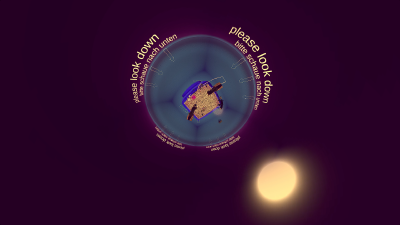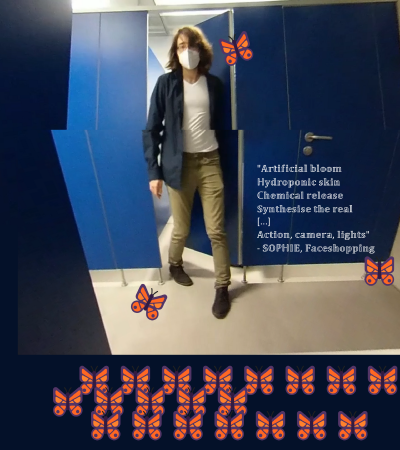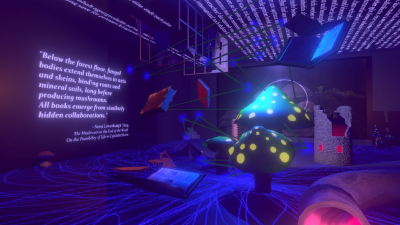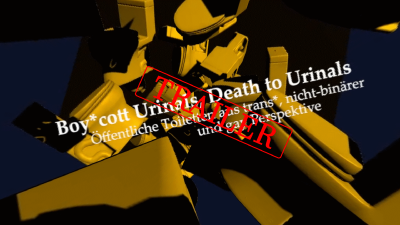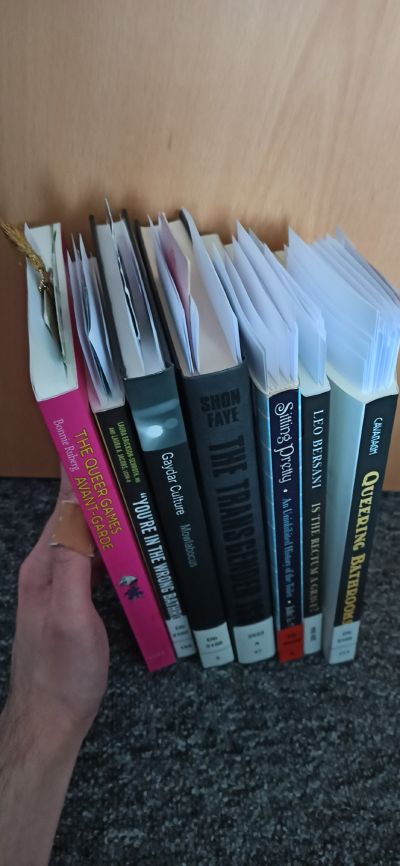It is with great regret that I have to inform you that I also am a YouTube video essayist now: Some initializing thoughts on immersive 360 essays & whatever a video game essay is (or could be); and an immersive video essay series in progress
Luka*s Friedland [---/luka/they] | M.F.A Medienkunst/Mediengestaltung | Immersive Essays | winter semester 2022/23
Luka*s Friedland [---/luka/they] (*1999) studied B.A. Creative Writing and Cultural Journalism, Media and Theatre at Hildesheim University and afterwards shortly M.A. Literary Studies: Texts.Signs.Media at Erfurt University. At time of writing, they is in their first semester in M.F.A. Media Art and Design.
I. At first: a trailer
The first thing that seems crucial to me when thinking about web video platforms and web series specifically is the initial materialization of ideas[1] onto the medium. Thinking about YouTube (filling a YouTube channel) for obvious reasons resulted in thinking about the term of the channel within media studies and to me, any visualization of a channel brings me instantly back to my childhood and a (seemingly huge) tube TV. (Fittingly, one of the earlier versions of the YouTube logo was akin to a tube TV too.) Memory is always cluttered and in the process of un-becoming, always endangered and terrifyingly out of control. There will be loss, there will be burn marks, there will be the multiple existential horrors of time (closely linked to certain death).
This brings me to my second visual: Next to the tube TV, white noise is of significant importance to me. White noise is error and feature at once, it draws our attention back to the medium, thus de-neutralizing, de-invisibilizing it, and at the same time its pleasing flickering creates an iconic aesthetic and a specific feeling of analog horror that got lost in the slow and steady digitization of everything. (Which is neither good nor bad, it’s just a neutral thing and a logical outcome of a process of changing medial landscapes.) Also, as a white person, to step into the background by conceptualizing yourself as unimportant white noise might be an interesting side note.
Therefore, I’m starting the trailer for my series with shortly initializing my “Datenkörper”[2]/data body/avatar on top of a tube TV, that shows white noise and a test screen for a brief moment. Other than that, this little first video is really just about trying to visualize my mess of ideas, currently still under construction and yet to be fully concretized. The camera’s tracking shot moves downwards to a little island among this equally messy sea, in which a shipwreck seemingly took place (maybe the real shipwreck is not the friends we made along the way, but me not getting done with the pilot episode during this semester :((( ).
The island is highly artificial[3], it is made out of plastic. Of course, to me, art will never fully capture and imitate life, because the medium is always between, and in this specific case, terrifying real-life phenomena like the Great Pacific Garbage Patch/Pacific trash vortex will always lurk in the background of any virtual plastic island and trash in harmless virtual waters. Although I certainly will never receive a Palme d’Or, at least in this medial artifact we are confronted with a golden palm tree in the middle of this island of abstracted plastic cubes. This palm tree doesn’t nod like, judging solely by the title and cover, the palm trees at Acapulco beach in a book by Charlotte Krafft. But it could potentially nod. (Or could it not?) And it could judge, silently judge my Datenkörper, like cis people might do on a daily basis. What it definitely does is effectively marking this island as an island, palm trees always do have a fascinating aesthetic quality to me and evoke distinct associations of specific locations with the presence of lots of sunlight.
The other obvious thing in the centre of this plastic cube island is a toilet. As Sheila L. Cavanagh notes[4], the bathroom stall is stereotypically associated with “femininity” and “gayness”, which of course speaks to me more, in contrast to the aggressively cisheteronormative- and masculine-coded urinal, in case I’d have to choose between these binaries: urinal and bathroom stall. What I did choose tho, is toilets/bathrooms/restrooms/lavatories as a topic for my pilot episode, specifically public bathrooms from a nonbinary and gay/androphile perspective and also medial representations of toilets and bathrooms, especially in video games. I am new at Bauhaus University, this is my first master’s semester here and as a trans* person, I guess I have a more ambivalent and existential relationship with toilets and public bathrooms, and the University’s binary-gendered lavatories therefore sparked my interest upon arriving and are in a cisnormative perception of course a strangely overlooked, but crucial part of every stay at Bauhaus, confronting myself with my non-fitting (a)gender identity (that I carry around with me in my silly little rucksack all day and sometimes I pull it out of my rucksack and gently give it a kiss on the forehead).
The video proceeds depicting a large box falling down and opening up; out comes a particle system lol, which of course is not just any particle system, but the concrete depiction of the arrival of ideas. The release of the ideas into this virtual space and into this whole upcoming series. When ideas are materially brought into existence/stated/noted down/expressed etc, something can start transforming out of them. After the ideas are materialized in some way, the concrete work can begin.
A short announcement with the overarching title[5] is then displayed. I chose RICHTUNGSLEGUNG (idk how to translate that, it’s not even a “real” German word, but a poetic neologism) for this, inspired by me remembering Anja Utler’s poem Rechnungslegung, that I came across in 2017[6]. This rather conceptual poem consists of a table with the task to form 10 correct sentences out of the fragments about loss of species, nature destruction and pollution. It is a very open form for a poem, which I really like, kind of a construction kit that like a game requires active participation by its audience. And with its open-ness and unfininished-ness I thought that this really fits for my stumbling into 360 videos and video essays and so on, eventhough I opened up the title even more by replacing the Rechnung/calculation part of it with Richtung/direction, because I also thought about one of the most Alman/German things to do, which is hiking, and the hiking trail signs, pointing in lots of directions, while also remaining a bit cryptic and even imprecise at times.
depicted: Luka Friedland, stumbling-stepping into the world of 360 videos, glitching, accompanied by some lines from SOPHIE’s Faceshopping
II. How I got here
If I remember correctly, the first 360 video on YouTube that I came across in my life was several years ago Dreams of Dalí by The Dalí Museum[7]. I won’t go into detail on that here, but it definitely is an interesting artifact that inspired me to look into 360 video at some point in my life – I guess this point is reached now, about 5-7 years later.
During the height of the COVID-19 pandemic, a lot of theatres were closed in Germany and switched to livestreams and other digital formats (oftentimes showing videos from their archives in not-so-good image quality). But there also was, for example, Sebastian Hartmann’s adaptation of Thomas Mann’s Der Zauberberg at Deutsches Theater Berlin, which premiered in November 2020 as a 360 livestream on YouTube. I think, therein lies a great potential for theatres to become more accessible to the public, and especially to people not living in the respective city/town/location etc. At the time of writing, I really would like to travel to Hamburg to watch Robert Wilson’s H – 100 seconds to midnight at Thalia Theater, but time- and moneywise I can’t afford it right now, and of course theatre is highly time-dependent and usually disappears after a certain number of stagings. The question of archiving such time- and bodily co-presence-dependent (leibliche Kopräsenz, Erika Fischer-Lichte) artworks is an important one.
I thought about creating this specific series of video essays for several years now, and also about essayistic video games[8], and I think it’s great to finally having found the opportunity starting to work on that. And finally asking myself the questions with an intention to propose personal little “solutions” to them: What is a video essay to me? What is an immersive essay to me? What is a video game essay to me?
In summer 2019 I held a workshop together with Anna Behrend as part of the summer literature week of wortbau e.V., a Berlin-based organization dedicated to providing a space for creative writing and literature to children and teens, in which we looked at several texts associated with écriture féminine, such as writings of Luce Irigaray, Hélène Cixous and Clarice Lispector. Around that time, I wrote an essay for Jenifer Becker’s seminar on the same topic at Hildesheim university, that inspired this workshop, in which I posed the question of how something like an écriture trans* could look and read like, to get away from the essentialist binaries of differential feminism (which one may also call TERF-feminism or which at least plays into the so-called “gender-critical feminist” anti-trans* hate ideologies today) that écriture féminine is associated with due to its specific historical emergence. I didn’t find an answer to anything, which is a great thing in the fields of cultural studies lol, but during the workshop I referenced a video essay by Natalie Wynn / ContraPoints for its aesthetic and linguistic potentialities. It would be a rewarding process for sure to develop a playful (→ ludic, even) poetology of an immersive essay that goes beyond a pure illustration of its contents using costumes as one can see within a certain emerging tradition of contemporary video essays. (And also, as a person who is at risk of poverty/armutsgefährdet, I think I might couldn’t afford that financially lol.) I would love to see video essays that push the boundaries of the medium more and that operate in specific ways that wouldn’t be possible in any other medium.
Looking back, I think that my first video game essay was a project that I did right after finishing my bachelor’s, and because it is very much influenced by the research I did for my theoretical thesis, one might call this my inofficial practical bachelor’s project: COMPLEX FEELINGS, a first explicit and major attempt of working with concrete poetry in a virtual space and also writing an essay that explicitly attempts institutional critique of the German literary scene and its anti-autistic ableism. And also I did a text mixtape video for the Austrian lecture series SEHR ERNSTE, which might be kind of my first long-form video essay, that is set in a virtual space created using Unity3D. Therefore, one might conclude that I’m not entirely new to this field, but just building upon all the things I’ve done before, like I always do.
The next step for me personally, that video essays could take in general, really is exploring 360 environments. But I don’t think that this will be the future of video essays as a whole, right now VR is way too niche and inaccessible for various reasons, and to always conceptualize a full 360 experience and thus giving up control over certain cinematic techniques/camera framing and passing more control to the audience is a challenge and takes lots of time and is quite complicated, which doesn’t fit into the mode of fast content consumption that most algorithms of these internet platforms are dependent on. My main focus right now (shifting once in a while) is, next to writing, video games & art games & theatre in theory and in artistic practice, and experimenting with video essays will be more of a side project of mine.
III. What I did during this semester for the Immersive Essays course
Okay, okay, okay, now to the actual core of this text! With all of the To-Dos piling up inside my head and all the mess that is life in general, I admittedly didn’t finish my pilot episode as of now, and I intentionally scoped my submissions for this class way smaller to not be too overwhelmed and paralyzed by everything instead of hustling and crunch-time-ing through it. So I decided to share some smaller results instead of one bigger one for now, and to write a longer text than required (as I would do anyways lol).
Adding to the trailer for the whole series, described above in the first part, I also did:
a) 5 experimental scenes, collage/anthology
I worked on the scenes that we created as introductory tutorials to Unity and fleshed them out more and put them together to form a little experimental collage, which I wanted to do anyways. I published a little collage/anthology on my itch.io.
In the first scene you walk around in an artificial landscape with trees while collecting cubes, which results in lines of poetry being displayed in another area, projected onto the UI.
The second scene might be my favourite; I mainly added the trees and other stuff and poetic lines referencing the trope in my literary texts of becoming a tree, which for example appears in my text Und langsam werden sie versinken, written in ca. early 2018 and first published in the anthology REIZÜBERFLUTUNG by Hildesheim literature students, that collects texts associated with Leonhard Hieronymi’s concept of Ultraromantik.
Scene 3 was an experimentation with Mixamo and MakeHuman, where I am referencing in my animation my favourite little thing in Greg Heffernan’s/Cosmo D’s Off-Peak, which is a person dancing on the train tracks with this same animation. (I always love to see games that are less polished and “uglier” (see also Jacob Geller’s video essay on “Bad Graphics”, where he references this game) than capitalism allows and that are employing elements of collage, grounding the practice of game development and making its aesthetics and means more accessible to other people and other developers.)
In scene number 4 I experimented with text as texture, which I would like to get more into, as for example Mez Breeze and Andy Campbell’s game All the Delicate Duplicates does. I also tried to use 360 video inside of a sphere with inverted normals I created using Blender, I think the lighting might failed a bit and it was generally hard to figure out how to properly display the video on a texture and material that looked like intended, but it’s okay. (I’m always embracing the constraints that my knowledge and the tools I’m using mean for my artistic work protocolling a specific moment in time.) An audio collage plays, made out of snippets from a speech by John F. Kennedy and some other original CC0 footage from the NASA archives. As lots of CC0-models are actually from museums, and I also used the Smithsonian 3D Digitization multiple times in the past, it might not be surprising that museum objects do appear.
The last scene was about trying out particle systems, I learned about different customization options this semester, next to the possibility of shadow options for lights, which was very helpful. Like in every one of my games, there is at least some little thing hidden to be discovered by the players.
I started using Unity3D in my childhood but didn’t really understood it back then, after several years I returned to it with some experiments in early 2020 with the help of Jonas Tyroller’s tutorials, and then figuring out specific things for projects along the way. But I never had a more in-depth introduction to Unity in person and I think that having had it now was helpful to me, and it was generally also a good thing to refresh things. I might do some more “classical game things” in the future, just for practicing, even though I’m usually less interested in the games played by gAmERsTM, but I also do play AAA-games and indie games that are more traditional in their game mechanics from time to time, but more to learn what things to avoid and to deconstruct in my own work lol.
I created another 360 video as a private project/idea, in which one sees several fruiting bodies of fungi and also their mycelium. I see this as a virtual video and audio installation, for that I finished a video that was initially intended for the student initiative bauhaus.bühne and inserted footage of mushrooms and ruins, that I associated with Anna Lowenhaupt Tsing’s The Mushroom at the End of the World. One can read a quote from that book on the left wall. I thought about one of my favourite fields within literature studies, which is in fact intertextuality (and with a broader definition of the term “text” also including intermediality), in relationship to this quote from the beginning of Tsing’s book, and added books and textual materialities to this room, the rest is mostly some models related to ruins and decay. Soundwise I dared to reuse again[9] some literary audio art that I created in summer semester 2021 for the project semester at Hildesheim university, which one can find on my Soundcloud. This project two years ago was all about gardening and music and sound and symbiosis and entanglements between nature and the arts, inspired by writings of Tsing and Merlin Sheldrake and mainly Donna J. Haraway and others. This sound was created back then using the Pure Data project audiozersetzer by Jens Schmidt and meshing/mushing together some webarticles[10] with Hannes Bajohr’s Automatengedichtautomat and distorting, fragmenting, pitching them etc.
During our project presentations in the course, Rosa Vill presented a project about mushrooms within ruins, and unfortunately I’m not sure if this specifically drew back my work from summer 2021 into my consciousness or not or how this contributed to/inspired this piece, it may or may not influenced it, and that’s why I wanted to quickly hint at that, thus making it transparent.
I read through lots of books and sources for my 360 video/video game essay on bathrooms, for which the script unfortunately isn’t finished and even organized yet. But the following picture shows some of my sources.
In the trailer for the pilot episode I’m experimenting with some material and footage that I already recorded using the Ricoh Theta V I’ve borrowed from the Digital Bauhaus Lab, and also compositions with models from the Unity Asset Store and Sketchfab that I’m recording in 360 directly in Unity using its recorder feature, following a tutorial[11].
I want to especially thank Corinna Rausch again for hinting at the wish for a nonbinary toilet scribbled in one of the Bauhaus University Library’s so-called “female” toilet stalls, depicted at the beginning of the trailer. I really do hope for a “restroom revolution”[12], as Clara Greed highlights, quoted in the trailer.
In art study programs and especially in gaming, there is this strange pressure and ambition to build up a portfolio to be eventually hired by some company to be part of some project under rather strict conditions and at the thin line to doing crunch time and inevitably sacrificing control over your free-time. I never understood this thriving, this wouldn’t be my dream work circumstances. To be hired is to be restricted by political agendas and normative ideologies and to be compromised in your ideas and visions by conservative people, because hierarchical organized positions of power usually attract conservative and non-marginalized people. It is an indication of the ongoing neoliberal capitalist infiltration of art, aiming at undermining systemic critique and alternatives beyond the contemporary capitalist realism (Mark Fisher).
With my stuff, I aim lower: To begin a project at all, and hence to overcome the fears that result in procrastination in the first place, is to me one of the most important things in art. (Even though, as Devon Price argues in his book Laziness Does Not Exist, there are always reasons for procrastination and a seemingly “lazy” behaviour on the surface.) This invisible borderline was crossed now. I’ve started. This crossing is valuable in itself.
References
[1] A person who sometimes talks in interviews about his relationship with getting ideas and fishing for ideas is David Lynch, and I’m in several aspects in line with his approach towards ideas, writing them down and connecting seemingly unrelated things over time. Cf. for example: Myers, Scott (2020): How to Write a Script: David Lynch. In: www.gointothestory.blcklst.com. URL: https://gointothestory.blcklst.com/how-to-write-a-script-david-lynch-b20d65f3018b [09.02.2023, 02:41]; American Film Institute (2011): David Lynch on Ideas. In: www.youtube.com. URL: https://www.youtube.com/watch?v=S2RFMCmfRmc [09.02.2023, 02:56]; dlftv (2009): David Lynch: ‚Ideas Are Like Fish.‘ In: www.youtube.com. URL: https://www.youtube.com/watch?v=hQGb3WFEhLQ [15.02.2023, 16:47]. (Of course, fishing is always a very brutal cultural practice that should be forbidden entirely, but imagining your inner self sitting at a little metaphorical pond waiting for idea-fishs is a very striking visual representation in my opinion.) Cf. also the documentary: David Lynch – The Art Life. Dir.: Rick Barnes, Olivia Neergaard-Holm and Jon Nguyen. US and DK 2016.
[2] Krämer, Sybille (2001): Medien – Körper – Performance. Zwischen Person und „persona“ – ein Gespräch. Sybille Krämer in a talk with Martina Leeker. p. 471. In: Leeker, Martina (Ed.): Maschinen, Medien, Performances: Theater an der Schnittstelle zu digitalen Welten. Alexander Verlag, Berlin 2001. pp. 471-479.
[3] On a side note, islands are very interesting in 3D video games and other virtual spaces, as they structure and limit the environment naturally, making the employment of invisible walls more or less obsolete. In my first bachelor’s semester I had a great seminar with Andreas Wolfsteiner on immersive theatre, in which we also talked about invisible walls as immersion-breaking in digital games. On another sidenote, as an autistic person, of course there is a specific ambivalent relationship that I have with the term Inselbegabung/savantism, because it is oftentimes employed in a way that reinforces anti-autistic ableism. Therefore, all of my islands are (meta)ironic, because I can’t separate my identity from the potential ableist violence caused by reinforcement of harmful stereotypes that lies within Inselbegabung.
[4] Cf. several passages in: Cavanagh, Sheila L. (2011): Queering Bathrooms: Gender, Sexuality, and the Hygienic Imagination. Reprinted edition. University of Toronto Press, Toronto/Buffalo/London 2011 [2010]. This book is really, really enriching and helpful regarding my research topic and will be one of my main sources.
[5] Titles are always a difficult thing and, according to Rudi Nuss, an art form in themselves. Generally, I prefer longer titles/poetic lines that open up Assoziationsräume over short and bold and boring ones (for these kinds of titles I would criticize for example most AAA-games). I think that a title should convince in itself, even if the actual content maybe doesn’t. The art of giving a title to an artwork is very much underappreciated.
[6] Cf. Utler, Anja (2017): Rechnungslegung. Republished from: Utler, Anja (2011): ausgeübt. Eine Kurskorrektur. Edition Korrespondenzen, Wien 2011. In: www.bundeswettbewerb-lyrix.de. URL: https://www.bundeswettbewerb-lyrix.de/wettbewerb/teile-plastik [19.02.2023, 18:24].
[7] The Dalí Museum (2016): Dreams of Dali: 360° Video. In: www.youtube.com. URL: https://www.youtube.com/watch?v=F1eLeIocAcU [15.02.2023, 17:51]. When referencing Salvador Dalí, I would also like to additionally reference a video essay by The Canvas about Dalí’s relationship with fascism: The Canvas (2020): Dali and Fascism. In: www.youtube.com. URL: https://www.youtube.com/watch?v=FecpubFKvcA [15.02.2023, 18:34]. Historical avant-garde movements are kind of a long term “guilty pleasure” & special interest of mine and despite being hugely important for the 20th Century art history of the so-called Global North, apparently not only the avant-garde movements with more openly fascist members, especially Futurism and Vorticism, had at least some members who weren’t entirely anti-fascist, thus contrasting the public reception of these movements. (Although the dada-movement was very explicitly anti-fascist.)
[8] When Mark Brown/Game Maker’s Toolkit released his interesting 2D interactive video essay Platformer Toolkit, judging by the title of the announcement video I was briefly worried that he could have done something similar to what I intended, but he did something completely else with this concept. (See: Game Maker’s Toolkit (2022): I Made a Video Essay That You Can PLAY. In: www.nebula.tv. URL: https://nebula.tv/videos/gmtk-i-made-a-video-essay-that-you-can-play [15.02.2023, 17:11] and Game Maker’s Toolkit (2022): Platformer Toolkit. In: www.itch.io. URL: https://gmtk.itch.io/platformer-toolkit [15.02.2023, 19:02].) Ideas are so random and art history is so artificial, depending on which person just randomly released a thing before someone else. Luckily, theories of intertextuality challenge the idea of any “original” creator behind any artwork. I would argue, that anyone could have the same idea as you and me, but maybe just not seeing any potential in it or not having the skills to realize it etc. There really isn’t anything unique about video games as essays, lots of indie games do it, lots of very niche people somewhere do it in medial artifacts that we just didn’t notice yet etc.
[9] Reuse again, because it is also part of a virtual museum installation I’ve been working on for years within the game Occupy White Walls.
[10] For the sources in detail see: Friedland, Luka*s (2021): von pilze fukushima (mushroomshrooms gartensample). In: www.soundcloud.com. URL: https://soundcloud.com/lukas-friedland/von-pilze-fukushima-mushroomshrooms-gartensample [19.02.2023, 15:50].
[11] Some tutorials that I used btw were: NPNL USC (2021): How to record a 360 video in Unity. In: www.youtube.com. URL: https://www.youtube.com/watch?v=9WEjMckJPFY [17.02.2023, 21:56]. And a video I used when working with green screen for the first time in early 2021 for a digital theatre project: Mtir’s Code (2021): How To Create Transparent Video From Green Screen Footage In Unity 3D 2021. In: www.youtube.com. URL: https://www.youtube.com/watch?v=ve_NQgrlfto [17.02.2023, 22:03].
[12] Greed, Clara (2003): Inclusive Urban Design: Public Toilets. Architectural Press, Oxford et al. 2003. p. 10.
